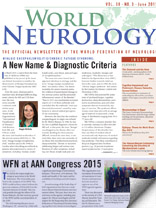By Mohammad Wasay and Wolfgang Grisold

Scenic Santiago, Chile, is the host city for the Congress
Epilepsy is one of the most common neurological diseases in world with an estimated more than 50 million people affected around world. It affects people of all ages. Almost 50 percent have a cause for these epileptic seizures, including stroke, brain trauma, infections, tumors or brain damage during or before delivery of a baby. It may cause three to six times increase risk of premature death. More than 80 percent live in developing countries, and almost 70 percent do not receive any treatment. Stigma and discrimination are important aspects of this treatable disease. More than 70 percent of people with epilepsy can lead a normal life with treatment. These were the facts and figures that inspired the World Federation of Neurology to select “epilepsy” as a theme for 2015 World Brain Day campaign.
2015 is a landmark year in history of epilepsy. The World Health Assembly adopted the resolution, titled “Global burden of epilepsy and the need for coordinated actions at the country level to address its health, social and public knowledge implications.” This resolution is a call for action from member countries and stakeholders.
The World Brain Day campaign will be jointly organized by WFN, the International League Against Epilepsy (ILAE) and the International Bureau of Epilepsy (IBE). Both of these organizations have been working for decades to improve public awareness, doctors’ training and advocacy. We urge our delegate societies to work with local ILAE and IBE chapters to organize World Brain Day 2015 activities. Our campaign will focus on prevention of epilepsy.
The Public Awareness and Advocacy Committee is in the process of preparing publicity material for this campaign. The material will include logos, banner ads for websites, handbills, brochures, posters, billboards and presentations. There will be a press conference in collaboration with the World Health Organization. A multilanguage press release will be prepared and circulated to delegate societies.
The most important target of this campaign is the public. We need to create simple messages in local languages and promote them via electronic, social media, billboards, banner and events. The next important area of intervention is health care authorities and policymakers. Our campaign should result in policy and priority shifts at the national or local level. We have to plan targeted activities to facilitate this outcome. Another important area of intervention is awareness and training of general practitioners, nurses and paramedical staff. Involvement of media is a must. Celebrities, scientists and sports figures with epilepsy could be a part of this advocacy campaign.
World Brain Day 2014 was a great success due to participation of large number of delegate national societies organizing activities and media events. Hundreds of newspaper items and media posts were created and shared via electronic, print and social media.
World Brain Day 2015 will be extremely productive in spreading the message all around globe, not only to affected people, doctors and health care authorities but to those normal, healthy people who are at risk for developing epilepsy. We can defeat epilepsy by awareness and effective treatment.
